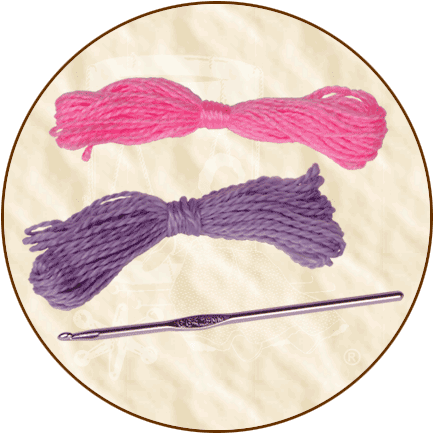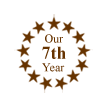.
Continued from product description
on Home Crafts' Page Six...
Historical
Background: The word "crochet" comes from the
French word "croc," meaning "a hook." Crochet
hooks come in a variety of sizes. The smallest crochet hooks
are used with fine cotton or silk thread to make laces and finery.
The regular size is perfect for personal items, such as blankets
and clothing (sweaters, scarves, hats, mittens, etc.). Jumbo
crochet hooks are available for use with jumbo yarn and to create
heavier items such as rugs.
Few examples of old crochet remnants remain because of deterioration,
but some have been located in Africa, China, Europe, Turkey,
North America, and South America. Crochet is similar to knitting
in the formation of loops, except that knitting uses two needles
and crochet only uses one. Crochet is called "shepherd's
knitting" in Scotland because of the caps and heavy cloaks
worn by shepherds made from this dense type of crochet. Pioneers
in early America reused wool from worn-out clothing and devised
the "granny square," which could be pieced together
to form a patchwork blanket, or made into clothing or bags.
The tiniest of crochet needles and the finest of threads were
used by nuns in Italy during the 16th century to make lace for
altar cloths and church garments. It became known as "nun's
lace" and quickly spread to Spain and Ireland. One particular
French émigré, Eleanore Riego de la Branchardiere,
moved to Ireland and became fascinated with the lace work of
the nuns at a convent in Dublin. She popularized this craft probably
more than any other person by publishing her work, including
newly devised stitches, in her magazine, The Needle. Two other
women taught this craft to women during the first half of the
19th century in homes set up for the poor, and their work from
these "homes" is still popular and named after their
origins: "Carrickmacross lace" and "Clones lace."
Knitting and crocheting are grouped together in many publications.
Many women's magazines began to promote these kinds of leisure
work for Victorian-era woman as a form of usefulness. Women had
more free time due to the technological advances of the day.
Since a woman must be doing something useful, she could crochet
or knit for charitable organizations or simply for her own personal
use. Some of the magazines included patterns for: table scarves
with crochet lace on the ends, yoke patterns to be used for a
camisole or nightgown, a tuxedo collar with matching cuffs, chair
backs, table cloth and napkin sets, and household linens. (The
list is long!) These "ladies of leisure" had to find
something to do with their hands. This might explain the frilly
appearance of Victorian homes decorated with lacy items covering
all sorts of furniture tops, sofa backs and chair arms.
Other forms of crochet, which resulted in lacy appearances,
are Filet crochet, Hairpin crochet, and Broomstick crochet. Filet
crochet became so popular that a deviation from it was thought
nice. The May, 1928, Needlework Magazine features "A Handsome
Border for Luncheon-Cloth or Centerpiece, with Matching Napkin-corner,
Tulip Design" and is described as being a "pleasing
change from the persistently popular filet-crochet." Surely
this became a most popular pattern! Hairpin crochet is worked
on a two-pronged steel loom, which looks like an enlarged hairpin.
The crochet hook works the thread or yarn loops between the prongs
of the tool. The prong is turned left to right after each stitch
is made. There are many beautiful variations and finished hairpin
lace can be used as an inset in fabrics near a hem or sleeve
edge, or it can be used to join other needlework pieces together.
"Broomstick lace" is made with a crochet hook and
a giant knitting needle. The size of the giant needle and crochet
hook determine the size of the stitch pattern. An entire garment
can be made with a broomstick lace pattern and it is fairly easy
to do. There is really only one stitch (one set of stitches,
that is) which is used in broomstick crochet.
Even if you are a beginner in crochet, it is easy to make
a small, pretty and/or useful item. There are so many choices
to make: small thread for doilies and Victorian pretties, two-ply
yarn for baby items, four-ply yarn to make a scarf, or rug yarn
for your very own personally designed rug. Our My First Crochet
Set will be a great beginning for anyone!













